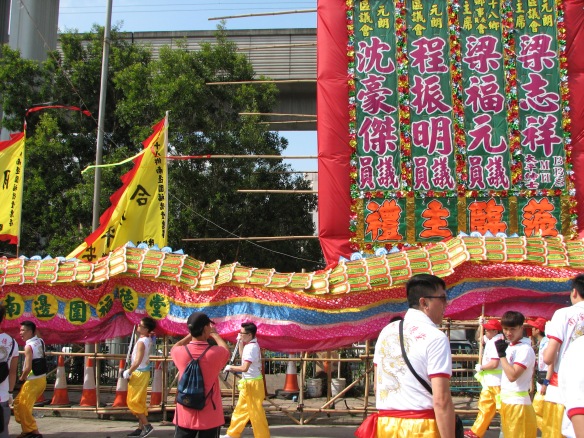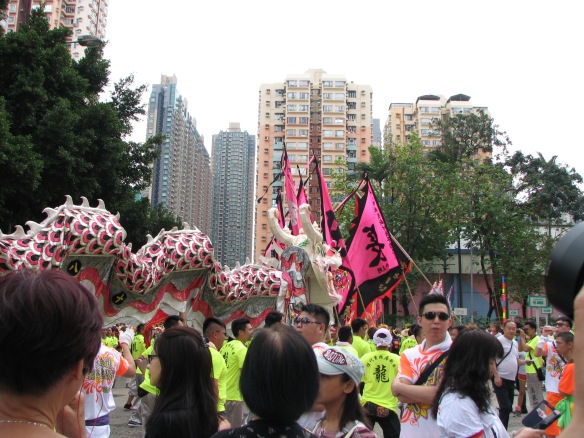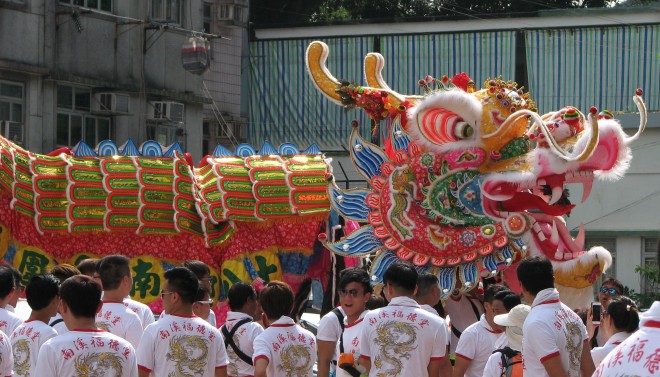 I just spent a few weeks visiting my sister and her family in Hong Kong. I was there in May, ahead of the rainy season. It’s already hot and humid, only a hint of the weather to come….
I just spent a few weeks visiting my sister and her family in Hong Kong. I was there in May, ahead of the rainy season. It’s already hot and humid, only a hint of the weather to come….
It can’t be a coincidence that this time of year is also the birthday of Tin Hau. [1, 2]

 She’s the Goddess of the Seas, patron saint of sailors and fishermen throughout China and Southeast Asia. Her festival is always held on the twenty-third day of the third lunar month of the lunar calendar. This year her birthday fell on May 11th. My friend Weiyu flew over from Beijing, and we had the good luck to see a dragon parade. [3]
She’s the Goddess of the Seas, patron saint of sailors and fishermen throughout China and Southeast Asia. Her festival is always held on the twenty-third day of the third lunar month of the lunar calendar. This year her birthday fell on May 11th. My friend Weiyu flew over from Beijing, and we had the good luck to see a dragon parade. [3]
 Lin Moniang (don’t forget that Chinese put the family name first) was born during the Song Dynasty on Meizhou Island in Fujian, China. Her dates are 23 March 960 – 4 October 987. She was the seventh daughter, an excellent swimmer, and wore a red dress. No matter how bad the weather was, Lin Moniang stood on the shore in that red dress in order to guide the fishing boats back home.
Lin Moniang (don’t forget that Chinese put the family name first) was born during the Song Dynasty on Meizhou Island in Fujian, China. Her dates are 23 March 960 – 4 October 987. She was the seventh daughter, an excellent swimmer, and wore a red dress. No matter how bad the weather was, Lin Moniang stood on the shore in that red dress in order to guide the fishing boats back home.
Wikipedia’s description of her legend is so good that I’ll repeat it verbatim here: “Lin Moniang’s father and brothers were fishermen. One day, a terrible typhoon arose while they were out at sea, and the rest of her family feared that those at sea had perished. In the midst of this storm, depending on the version of the legend, she fell into a trance while praying for the lives of her father and brothers or dreamed of her father and brothers while she was sleeping or sitting at a loom weaving. In both versions of the story, her father and brother were drowning but Moniang’s mother discovered her sleeping and tried to wake her. This diverted Moniang’s attention and caused her to drop her brother who drowned as a result. Consequently, Moniang’s father returned alive and told the other villagers that a miracle had happened.” [4]
 She was deified shortly after her death. There are many reports of miraculous sightings of Tin Hau by sailors in distress. Chinese who immigrated often built temples once they arrived overseas to thank her for the safe journey. Each year a major festival is held on her birthday.
She was deified shortly after her death. There are many reports of miraculous sightings of Tin Hau by sailors in distress. Chinese who immigrated often built temples once they arrived overseas to thank her for the safe journey. Each year a major festival is held on her birthday.
One of the most spectacular is in Yuen Long in the New Territories. Weiyu and I headed out early to reach the town (an easy trip on the MTR, the wonderful regional transportation system). We left the metro station and immediately saw bright colors and a crowd of people. As we got closer, firecrackers began to go off! We’d arrived right on time!


 This village had just begun to parade their dragon. They circled the lot a few times accompanied by a loud drum and cymbals. There was another loud bang, more firecrackers popped, and everyone followed the dragon as it headed into town.
This village had just begun to parade their dragon. They circled the lot a few times accompanied by a loud drum and cymbals. There was another loud bang, more firecrackers popped, and everyone followed the dragon as it headed into town.

 We arrived at another square where more dragons waited.
We arrived at another square where more dragons waited.

 They took turns weaving up and down the main street, curling and snaking, rising and falling in an intricate dance. Sometimes two dragons danced at the same time.
They took turns weaving up and down the main street, curling and snaking, rising and falling in an intricate dance. Sometimes two dragons danced at the same time.

 People’s shirts indicated which village and dragon they were with. There were groups of old women waving fans, and children in costume, and lions.
People’s shirts indicated which village and dragon they were with. There were groups of old women waving fans, and children in costume, and lions. 



 Flags and banners waved around the Fa Paus, ornate towers with paper flowers. Huge elaborate placards wished for luck and prosperity.
Flags and banners waved around the Fa Paus, ornate towers with paper flowers. Huge elaborate placards wished for luck and prosperity.



 Offerings included entire roasted pigs.
Offerings included entire roasted pigs.

 I recognized those instantly from the worship of Bà Chúa Xứ in southern Viet Nam. It can’t be a coincidence that her festival starts at the beginning of the rainy season on the twenty-third day of a lunar month too…
I recognized those instantly from the worship of Bà Chúa Xứ in southern Viet Nam. It can’t be a coincidence that her festival starts at the beginning of the rainy season on the twenty-third day of a lunar month too…
NOTES: [1] Tianhou (天后) literally means “Empress of Heaven”. [2] She’s also known as Mazu, Tian Fei or A-Ma. The Buddhists conflated her into a reincarnation of Guan Yin, Goddess of Compassion. [3] She has over 90 temples in Hong Kong alone. [4] http://en.wikipedia.org/wiki/Mazu
Photos Copyright © 2015 Jadi Campbell. All photographs can be enlarged by simply clicking on the image.
Go to my post The Cult of Bà Chúa Xứ to read about south Viet Nam’s most sacred shrine. More pictures from our trips to Vietnam and China and of Uwe’s photography may be viewed at viewpics.de.
http://www.asiaatsea.com/tin-hau-chinese-goddess-of-the-sea/
http://en.wikipedia.org/wiki/Mazu
http://scalar.usc.edu/anvc/travel-and-culture-in-hong-kong-and-macau/tin-hau


































